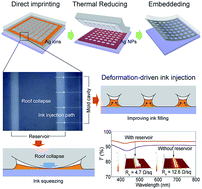Direct imprinting of thermally reduced silver nanoparticles via deformation-driven ink injection for high-performance, flexible metal grid embedded transparent conductors†
Abstract
We developed a method for direct imprinting of thermally reduced Ag nanoparticles via deformation-driven ink injection to yield high-performance metal grid transparent conductors (TCs). A grid patterned mold was created to have a macroscale cavity by designing a “reservoir” that captured outgoing ink and injected the captured ink into the grid patterned mold cavity by a roof deformation. The ink supply from the reservoir contributed to not only improving the ink filling, but also decreasing the linewidth of the grid patterned mold cavity due to a sidewall deformation on the liquid film. The metal grid TCs fabricated using the reservoir-assisted mold performed better than the metal grids prepared using the typical mold in terms of the sheet resistance (4.7 vs. 12.6 Ω sq−1) and transmittance at 550 nm (93.5 vs. 90.7%), respectively. The metal grid TCs were embedded into large-scale, flexible, and transparent films, which showed a reasonable electromechanical stability under repeated bending. The metal grid embedded TCs were fabricated for application in touch screen panels. Our approach provides a new route for fabrication of high-performance, solution-processed micro/nanoscale metal grid TCs and hybrid TCs based on Ag nanowires, graphene, or carbon nanotubes for use in a variety of next-generation flexible optoelectronic devices.


 Please wait while we load your content...
Please wait while we load your content...